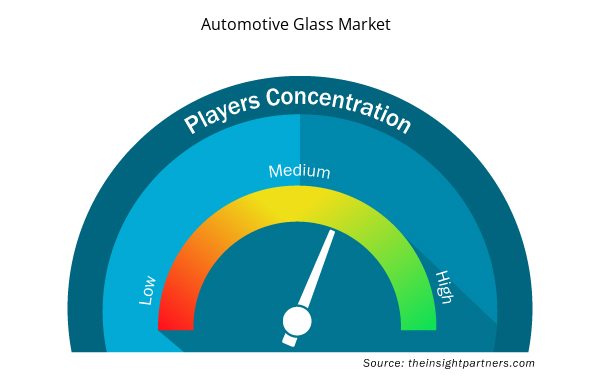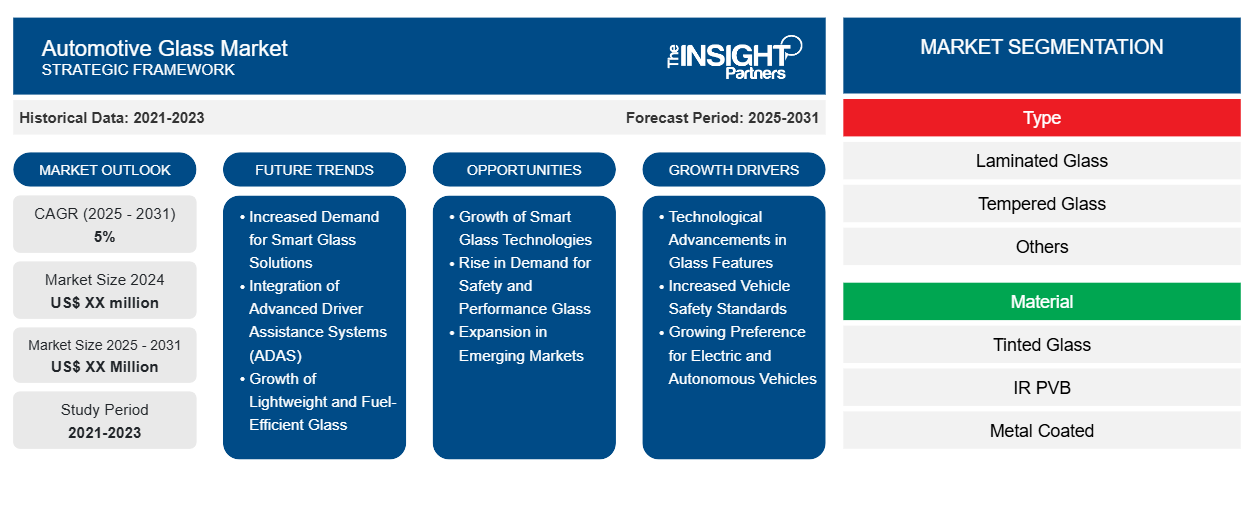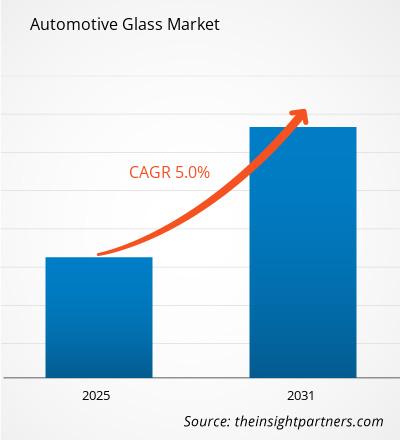Le marché du verre automobile devrait enregistrer un TCAC de 5 % de 2023 à 2031, avec une taille de marché passant de XX millions USD en 2023 à XX millions USD d'ici 2031.
Le rapport est segmenté par type (verre feuilleté, verre trempé, autres). Le rapport présente en outre une analyse basée sur le matériau (verre teinté, PVB IR, revêtement métallique, autres). Sur la base du type de véhicule, le rapport est segmenté en (véhicules de tourisme, véhicules utilitaires légers (LCV), véhicules utilitaires lourds et deux-roues et autres). L'analyse globale est ensuite décomposée au niveau régional et par principaux pays. Le rapport offre la valeur en USD pour l'analyse et les segments ci-dessus.
Objectif du rapport
Le rapport sur le marché du verre automobile de The Insight Partners vise à décrire le paysage actuel et la croissance future, les principaux facteurs moteurs, les défis et les opportunités. Cela fournira des informations à diverses parties prenantes commerciales, telles que :
- Fournisseurs/fabricants de technologie : pour comprendre l’évolution de la dynamique du marché et connaître les opportunités de croissance potentielles, leur permettant de prendre des décisions stratégiques éclairées.
- Investisseurs : Effectuer une analyse complète des tendances concernant le taux de croissance du marché, les projections financières du marché et les opportunités qui existent tout au long de la chaîne de valeur.
- Organismes de réglementation : Réglementer les politiques et surveiller les activités du marché dans le but de minimiser les abus, de préserver la confiance des investisseurs et de maintenir l’intégrité et la stabilité du marché.
Segmentation du marché du verre automobile
Taper
- Verre feuilleté
- Verre trempé
- Autres
Matériel
- Verre teinté
- PVB infrarouge
- Revêtement métallique
- Autres
Personnalisez ce rapport en fonction de vos besoins
Vous bénéficierez d'une personnalisation gratuite de n'importe quel rapport, y compris de certaines parties de ce rapport, d'une analyse au niveau des pays, d'un pack de données Excel, ainsi que de superbes offres et réductions pour les start-ups et les universités.
- Obtenez les principales tendances clés du marché de ce rapport.Cet échantillon GRATUIT comprendra une analyse de données, allant des tendances du marché aux estimations et prévisions.
Facteurs de croissance du marché du verre automobile
- Progrès technologiques dans les caractéristiques du verre : Le marché du verre automobile est stimulé par des innovations telles que les technologies de verre chauffant, teinté et intelligent. Ces caractéristiques améliorent le confort, la sécurité et l'efficacité énergétique. Par exemple, le verre électrochrome, qui ajuste sa teinte en fonction de la lumière du soleil, devient de plus en plus populaire dans les véhicules haut de gamme.
- Normes de sécurité renforcées pour les véhicules : l'accent étant mis de plus en plus sur l'amélioration de la sécurité des véhicules, la demande de verre feuilleté et trempé, qui offre une meilleure résistance aux chocs, est en hausse. Les fabricants de verre automobile intègrent des fonctionnalités de sécurité telles que les systèmes avancés d'aide à la conduite (ADAS) dans leurs produits, ce qui stimule encore davantage la croissance du marché.
- Préférence croissante pour les véhicules électriques et autonomes : L'essor des véhicules électriques et autonomes contribue à la demande de matériaux en verre avancés. Par exemple, les toits panoramiques, les écrans de réalité augmentée et le verre auto-réparateur gagnent en popularité dans les véhicules électriques et autonomes, ce qui entraîne le besoin de nouveaux types de solutions de verre automobile.
Tendances futures du marché du verre automobile
- Demande accrue de solutions de vitrage intelligent : le marché du vitrage automobile devrait connaître une croissance significative dans les années à venir avec l'adoption de technologies de vitrage intelligent. Ces innovations comprennent le verre électrochromique et photochromique, qui change de teinte en fonction de la luminosité, améliorant ainsi le confort, l'intimité et l'efficacité énergétique des occupants du véhicule.
- Intégration des systèmes avancés d'aide à la conduite (ADAS) : à mesure que les technologies ADAS se généralisent dans les véhicules, le vitrage automobile intégrera de plus en plus de capteurs, de caméras et de systèmes d'affichage tête haute. Cette tendance entraînera une augmentation de la demande de solutions de vitrage spécialisées qui s'intègrent parfaitement aux technologies ADAS pour améliorer la sécurité du véhicule et l'expérience du conducteur.
- Croissance du verre léger et économe en carburant : En réponse à la demande croissante de véhicules économes en énergie, l'utilisation de matériaux en verre légers qui contribuent à la réduction du poids global des véhicules devrait augmenter. Ces matériaux amélioreront non seulement le rendement énergétique, mais aussi les performances globales du véhicule et réduiront les émissions.
Opportunités du marché du verre automobile
- Croissance des technologies de verre intelligent : le verre automobile avec des technologies intégrées telles que l'auto-atténuation, les capteurs tactiles et les affichages tête haute offre des opportunités de marché importantes. L'adoption croissante du verre intelligent, en particulier dans les véhicules de luxe et électriques, stimule la demande de solutions de verre automobile avancées qui améliorent le confort, la sécurité et l'expérience de conduite globale.
- Hausse de la demande de verres de sécurité et de performance : avec l'augmentation des normes de sécurité des véhicules et les attentes des consommateurs en matière de meilleure protection, la demande de verre automobile intégrant des caractéristiques telles que le verre de sécurité feuilleté, le verre incassable et la protection UV augmente. Cela offre aux entreprises l'opportunité de développer des solutions de verre avancées qui répondent à ces besoins en constante évolution.
- Expansion sur les marchés émergents : le marché du verre automobile devrait connaître une croissance significative dans les économies émergentes où la production et le nombre de véhicules sont en hausse. À mesure que les infrastructures s'améliorent et que le revenu disponible augmente, la demande de verre automobile de meilleure qualité va augmenter, notamment en solutions de verre durables et économes en énergie pour les véhicules de milieu de gamme et haut de gamme.
Aperçu régional du marché du verre automobile
Les tendances régionales et les facteurs influençant le marché du verre automobile tout au long de la période de prévision ont été expliqués en détail par les analystes d’Insight Partners. Cette section traite également des segments et de la géographie du marché du verre automobile en Amérique du Nord, en Europe, en Asie-Pacifique, au Moyen-Orient et en Afrique, ainsi qu’en Amérique du Sud et en Amérique centrale.

- Obtenez les données régionales spécifiques au marché du verre automobile
Portée du rapport sur le marché du verre automobile
| Attribut de rapport | Détails |
|---|---|
| Taille du marché en 2023 | XX millions de dollars américains |
| Taille du marché d'ici 2031 | XX millions de dollars américains |
| Taux de croissance annuel composé mondial (2023-2031) | 5% |
| Données historiques | 2021-2022 |
| Période de prévision | 2024-2031 |
| Segments couverts | Par type
|
| Régions et pays couverts | Amérique du Nord
|
| Leaders du marché et profils d'entreprises clés |
|
Densité des acteurs du marché du verre automobile : comprendre son impact sur la dynamique commerciale
Le marché du verre automobile connaît une croissance rapide, tirée par la demande croissante des utilisateurs finaux en raison de facteurs tels que l'évolution des préférences des consommateurs, les avancées technologiques et une plus grande sensibilisation aux avantages du produit. À mesure que la demande augmente, les entreprises élargissent leurs offres, innovent pour répondre aux besoins des consommateurs et capitalisent sur les tendances émergentes, ce qui alimente davantage la croissance du marché.
La densité des acteurs du marché fait référence à la répartition des entreprises ou des sociétés opérant sur un marché ou un secteur particulier. Elle indique le nombre de concurrents (acteurs du marché) présents sur un marché donné par rapport à sa taille ou à sa valeur marchande totale.
Les principales entreprises opérant sur le marché du verre automobile sont :
- AGC Inc
- Corning Incorporated
- Groupe industriel du verre Fuyao Co. Ltd.
- Société Gentex
- Les industries Guardian
Avis de non-responsabilité : les sociétés répertoriées ci-dessus ne sont pas classées dans un ordre particulier.

- Obtenez un aperçu des principaux acteurs du marché du verre automobile
Principaux arguments de vente
- Couverture complète : Le rapport couvre de manière exhaustive l’analyse des produits, des services, des types et des utilisateurs finaux du marché du verre automobile, offrant un paysage holistique.
- Analyse d’experts : Le rapport est compilé sur la base d’une compréhension approfondie des experts et analystes du secteur.
- Informations à jour : Le rapport garantit la pertinence commerciale en raison de sa couverture des informations récentes et des tendances des données.
- Options de personnalisation : ce rapport peut être personnalisé pour répondre aux exigences spécifiques du client et s'adapter parfaitement aux stratégies commerciales.
Le rapport de recherche sur le marché du verre automobile peut donc aider à ouvrir la voie au décodage et à la compréhension du scénario de l’industrie et des perspectives de croissance. Bien qu’il puisse y avoir quelques préoccupations valables, les avantages globaux de ce rapport ont tendance à l’emporter sur les inconvénients.
- Analyse historique (2 ans), année de base, prévision (7 ans) avec TCAC
- Analyse PEST et SWO
- Taille du marché Valeur / Volume - Mondial, Régional, Pays
- Industrie et paysage concurrentiel
- Ensemble de données Excel



Report Coverage
Revenue forecast, Company Analysis, Industry landscape, Growth factors, and Trends

Segment Covered
This text is related
to segments covered.

Regional Scope
North America, Europe, Asia Pacific, Middle East & Africa, South & Central America

Country Scope
This text is related
to country scope.
Questions fréquemment posées
Based on geography, Asia Pacific held the largest share of the automotive glass market due to the well-established automotive industry across the region
Increased demand for smart glass solutions is expected to be the key market trends.
Based on type, tempered glass segment is expected to witness the fastest growth during the forecast period
The Automotive Glass Market is estimated to witness a CAGR of 5% from 2023 to 2031
Technological advancements in glass features is driving the automotive glass market growth.
AGC Inc, Corning Incorporated, Fuyao Glass Industry Group Co. Ltd, Gentex Corporation, Guardian Industries, Nippon Sheet Glass Co., Ltd are some of the key players operating in the automotive glass market
Trends and growth analysis reports related to Chemicals and Materials : READ MORE..
The List of Companies
1.AGC Inc
2.Corning Incorporated
3.Fuyao Glass Industry Group Co. Ltd
4.Gentex Corporation
5.Guardian Industries
6.Nippon Sheet Glass Co., Ltd
7.Saint-Gobain Sekurit
8.Sisecam Group
9.Vitro SAB de CV
10.Xinyi Glass Holdings Ltd.
The Insight Partners performs research in 4 major stages: Data Collection & Secondary Research, Primary Research, Data Analysis and Data Triangulation & Final Review.
- Data Collection and Secondary Research:
As a market research and consulting firm operating from a decade, we have published and advised several client across the globe. First step for any study will start with an assessment of currently available data and insights from existing reports. Further, historical and current market information is collected from Investor Presentations, Annual Reports, SEC Filings, etc., and other information related to company’s performance and market positioning are gathered from Paid Databases (Factiva, Hoovers, and Reuters) and various other publications available in public domain.
Several associations trade associates, technical forums, institutes, societies and organization are accessed to gain technical as well as market related insights through their publications such as research papers, blogs and press releases related to the studies are referred to get cues about the market. Further, white papers, journals, magazines, and other news articles published in last 3 years are scrutinized and analyzed to understand the current market trends.
- Primary Research:
The primarily interview analysis comprise of data obtained from industry participants interview and answers to survey questions gathered by in-house primary team.
For primary research, interviews are conducted with industry experts/CEOs/Marketing Managers/VPs/Subject Matter Experts from both demand and supply side to get a 360-degree view of the market. The primary team conducts several interviews based on the complexity of the markets to understand the various market trends and dynamics which makes research more credible and precise.
A typical research interview fulfils the following functions:
- Provides first-hand information on the market size, market trends, growth trends, competitive landscape, and outlook
- Validates and strengthens in-house secondary research findings
- Develops the analysis team’s expertise and market understanding
Primary research involves email interactions and telephone interviews for each market, category, segment, and sub-segment across geographies. The participants who typically take part in such a process include, but are not limited to:
- Industry participants: VPs, business development managers, market intelligence managers and national sales managers
- Outside experts: Valuation experts, research analysts and key opinion leaders specializing in the electronics and semiconductor industry.
Below is the breakup of our primary respondents by company, designation, and region:

Once we receive the confirmation from primary research sources or primary respondents, we finalize the base year market estimation and forecast the data as per the macroeconomic and microeconomic factors assessed during data collection.
- Data Analysis:
Once data is validated through both secondary as well as primary respondents, we finalize the market estimations by hypothesis formulation and factor analysis at regional and country level.
- Macro-Economic Factor Analysis:
We analyse macroeconomic indicators such the gross domestic product (GDP), increase in the demand for goods and services across industries, technological advancement, regional economic growth, governmental policies, the influence of COVID-19, PEST analysis, and other aspects. This analysis aids in setting benchmarks for various nations/regions and approximating market splits. Additionally, the general trend of the aforementioned components aid in determining the market's development possibilities.
- Country Level Data:
Various factors that are especially aligned to the country are taken into account to determine the market size for a certain area and country, including the presence of vendors, such as headquarters and offices, the country's GDP, demand patterns, and industry growth. To comprehend the market dynamics for the nation, a number of growth variables, inhibitors, application areas, and current market trends are researched. The aforementioned elements aid in determining the country's overall market's growth potential.
- Company Profile:
The “Table of Contents” is formulated by listing and analyzing more than 25 - 30 companies operating in the market ecosystem across geographies. However, we profile only 10 companies as a standard practice in our syndicate reports. These 10 companies comprise leading, emerging, and regional players. Nonetheless, our analysis is not restricted to the 10 listed companies, we also analyze other companies present in the market to develop a holistic view and understand the prevailing trends. The “Company Profiles” section in the report covers key facts, business description, products & services, financial information, SWOT analysis, and key developments. The financial information presented is extracted from the annual reports and official documents of the publicly listed companies. Upon collecting the information for the sections of respective companies, we verify them via various primary sources and then compile the data in respective company profiles. The company level information helps us in deriving the base number as well as in forecasting the market size.
- Developing Base Number:
Aggregation of sales statistics (2020-2022) and macro-economic factor, and other secondary and primary research insights are utilized to arrive at base number and related market shares for 2022. The data gaps are identified in this step and relevant market data is analyzed, collected from paid primary interviews or databases. On finalizing the base year market size, forecasts are developed on the basis of macro-economic, industry and market growth factors and company level analysis.
- Data Triangulation and Final Review:
The market findings and base year market size calculations are validated from supply as well as demand side. Demand side validations are based on macro-economic factor analysis and benchmarks for respective regions and countries. In case of supply side validations, revenues of major companies are estimated (in case not available) based on industry benchmark, approximate number of employees, product portfolio, and primary interviews revenues are gathered. Further revenue from target product/service segment is assessed to avoid overshooting of market statistics. In case of heavy deviations between supply and demand side values, all thes steps are repeated to achieve synchronization.
We follow an iterative model, wherein we share our research findings with Subject Matter Experts (SME’s) and Key Opinion Leaders (KOLs) until consensus view of the market is not formulated – this model negates any drastic deviation in the opinions of experts. Only validated and universally acceptable research findings are quoted in our reports.
We have important check points that we use to validate our research findings – which we call – data triangulation, where we validate the information, we generate from secondary sources with primary interviews and then we re-validate with our internal data bases and Subject matter experts. This comprehensive model enables us to deliver high quality, reliable data in shortest possible time.


 Obtenez un échantillon gratuit pour ce rapport
Obtenez un échantillon gratuit pour ce rapport